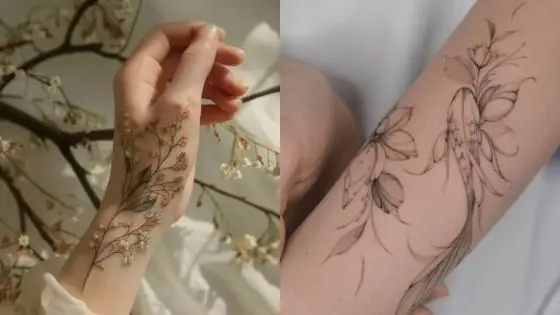Beach tattoos capture the essence of coastal living. They offer a permanent reminder of tranquil waves, sandy shores, and endless summer days. From delicate seashells to vibrant sunsets, these designs celebrate everything we love about oceanside experiences.
Beach-inspired tattoos have surged in popularity. They connect wearers to cherished memories while expressing a free-spirited lifestyle. Many people choose these designs after meaningful vacations, as symbols of personal transformation, or simply to carry a piece of paradise with them always.
The versatility of beach tattoos makes them appealing to both tattoo enthusiasts and first-timers alike. They can be as simple as a minimalist wave outline or as elaborate as a detailed tropical landscape, allowing everyone to find their perfect seaside expression.
Exploring Beach Tattoo Meanings
Beach tattoos hold deep significance for many people, capturing memories, emotions, and personal connections to coastal environments. These designs often carry multiple layers of meaning that reflect one’s relationship with the sea and shore.
Symbolism of the Ocean


The ocean in beach tattoos represents the vastness of life and its constant state of change. Waves symbolize the ebbs and flows of personal journeys. Larger waves often depict significant life challenges that have been overcome.
Small, gentle waves may represent peace and tranquility found at the shoreline. Many people choose ocean imagery to honor loved ones lost at sea or to commemorate important moments that occurred near water.
The blue tones commonly used in ocean tattoos can signify depth, wisdom, and emotional healing. For sailors and maritime workers, these tattoos often serve as protective symbols and reminders of home while at sea.
Connection to Nature
Beach tattoos celebrate the natural world and one’s place within coastal ecosystems. Palm trees, seashells, and marine life like dolphins or turtles each carry their own meaning within beach tattoo designs.
Seashells often represent protection, good fortune, and the journey of life. Their spiral patterns symbolize growth and evolution. Meanwhile, marine creatures like sea turtles represent longevity, patience, and wisdom.
Beach landscapes capture the meeting point between elements—earth, water, and sky. This intersection symbolizes balance and harmony in one’s life. Many choose beach tattoos to express their commitment to environmental conservation and ocean protection.
Common Nature Elements in Beach Tattoos:
- Palm trees: paradise, relaxation, tropical lifestyle
- Seashells: protection, good fortune, natural beauty
- Starfish: renewal, intuition, guidance
Freedom and Adventure



Beach tattoos frequently embody the free-spirited nature associated with coastal living. Sailboats and lighthouses represent journeys, guidance, and the pursuit of new horizons.
For travelers and adventurers, beach tattoos serve as permanent souvenirs of special destinations or transformative experiences. Compass designs incorporated into beach tattoos symbolize direction, purpose, and the spirit of exploration.
Many surfers and water sports enthusiasts choose wave tattoos to celebrate their passion and the thrill of riding the ocean’s power. These designs often capture the exhilaration and freedom felt in these moments.
Beach sunset tattoos represent beauty, peace, and the appreciation of life’s fleeting moments. They remind wearers to pause and enjoy the present, much like the experience of watching day transition to night along the shore.
Popular Beach Tattoo Designs
Beach tattoos come in a variety of stunning designs that capture the essence of coastal life and ocean adventures. From iconic palm trees to dynamic waves and colorful marine creatures, these tattoos allow people to carry a piece of the beach with them wherever they go.
Palm Trees and Sunsets
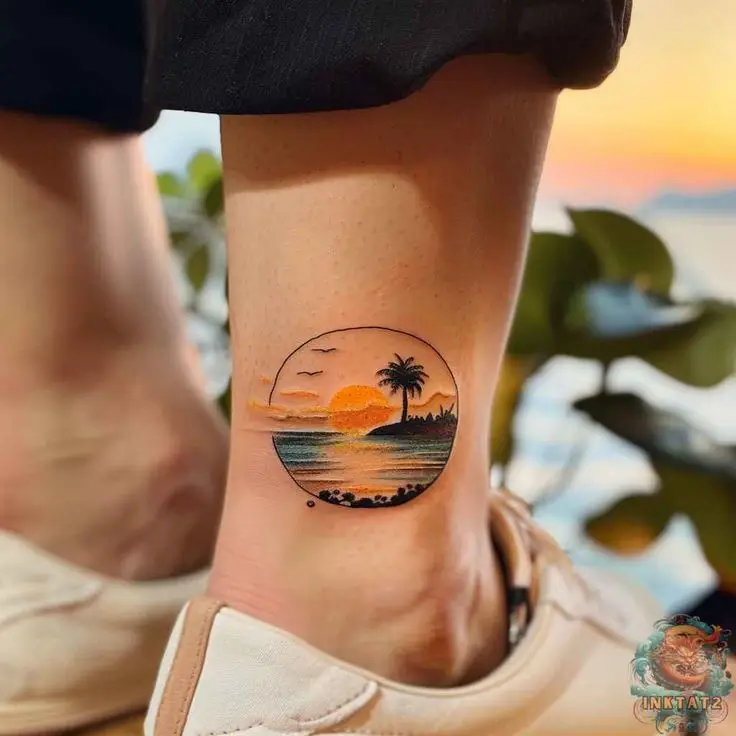
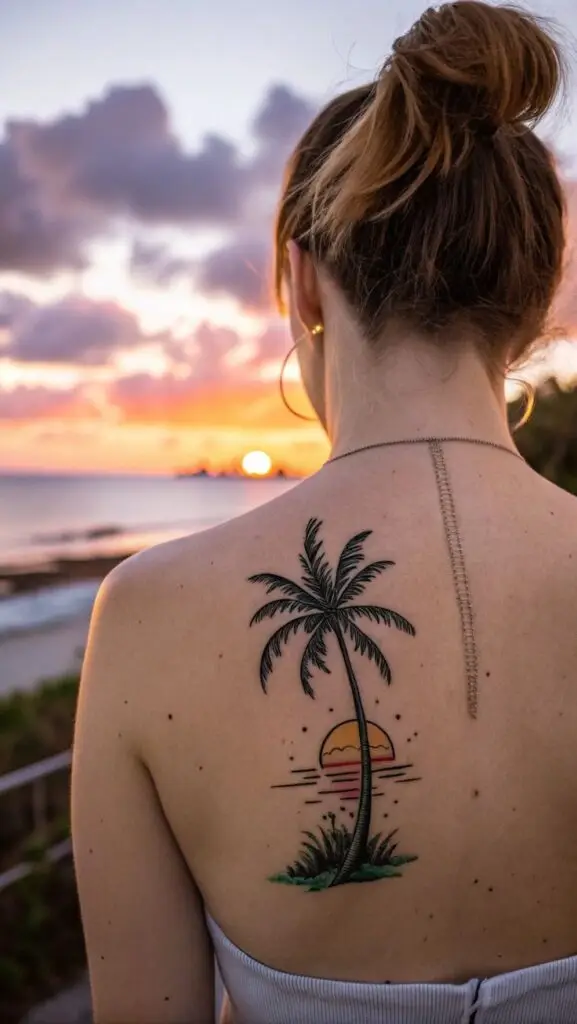
Palm trees symbolize tropical paradise and relaxation, making them one of the most sought-after beach tattoo designs. These iconic trees can be inked in various styles, from minimalist black outlines to detailed colorful representations with textured trunks and fronds.
Sunset scenes create dramatic and colorful tattoos that evoke feelings of peace and reflection. Artists often incorporate vibrant oranges, reds, and purples to capture that magical moment when the sun meets the horizon over the ocean.
Popular palm tree and sunset design variations:
- Silhouetted palm trees against a watercolor sunset
- Coconut palms with detailed fronds
- Palm trees with hammocks for a relaxation theme
- Circular sunset designs with palm tree outlines
- Geometric palm tree patterns
Waves and Water Patterns

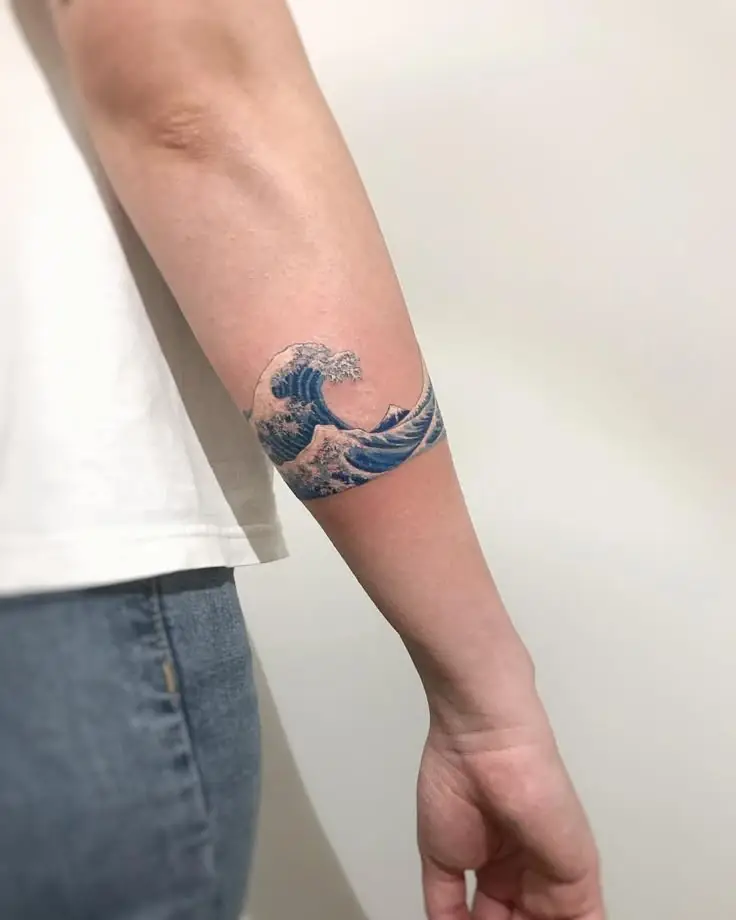
Wave tattoos represent the powerful, ever-changing nature of the ocean and life itself. Simple line-work waves offer a clean, minimalist approach while detailed waves can showcase incredible movement and depth.
Water patterns like the traditional Japanese style “seigaiha” (overlapping wave) design have become increasingly popular for their aesthetic appeal and symbolic meaning of resilience and continuity.
Many beach enthusiasts choose wave tattoos that represent famous surf spots or memorable beaches they’ve visited. These designs often incorporate realistic water textures with white foam caps and varying shades of blue.
Wave design styles:
- Continuous line waves
- Geometric ocean patterns
- Japanese-inspired wave art
- Realistic breaking waves
- Abstract water elements
Marine Life Motifs



Sea creatures make captivating tattoo subjects that celebrate ocean biodiversity. Dolphins, whales, and sea turtles rank among the most requested marine life tattoos, symbolizing freedom, wisdom, and longevity respectively.
Small clusters of colorful fish, seahorses, and starfish create playful designs that can be placed anywhere on the body. These motifs work beautifully in both realistic and stylized interpretations.
Shell designs offer elegant simplicity while still maintaining a strong beach connection. Conch shells, scallops, and nautilus patterns are particularly popular for their natural geometric beauty.
Popular marine tattoo combinations:
- Sea turtles surrounded by coral
- Schools of tropical fish in vibrant colors
- Whale tails breaking the water’s surface
- Detailed seahorses with flowing tails
- Nautical stars paired with seashells
Choosing the Right Placement


Selecting the perfect spot for a beach tattoo requires careful consideration of both aesthetics and personal meaning. The placement will significantly impact how your coastal-inspired art looks and feels over time.
Visibility and Personal Significance
Beach tattoos can be showcased or kept as private treasures depending on placement choice. Popular visible locations include the forearm, ankle, and shoulder blade, which allow for easy display during beach outings.
The wrist and inner forearm work well for wave patterns or small seashell designs that you want to glimpse throughout the day. Many people choose these spots for daily reminders of special beach memories.
For more personal or meaningful beach tattoos, areas like the ribcage, upper thigh, or back offer larger canvases while remaining discreet when desired. These locations can accommodate more detailed beach landscapes or ocean scenes.
Popular Beach Tattoo Placements:
- Ankle/foot (for wave designs and small symbols)
- Forearm (for medium-sized artistic pieces)
- Back/shoulder (for larger beach scenes)
- Ribcage (for personal, hidden pieces)
Size and Detail Considerations
The size of your beach tattoo should align with your chosen placement. Smaller areas like wrists or ankles best suit minimalist designs such as tiny shells, simple waves, or small anchors.
Intricate beach landscapes or detailed maritime scenes require larger canvas areas like the back, thigh, or chest. These spaces allow the tattoo artist to include fine details of shorelines, realistic waves, or complex underwater scenes.
Consider how the natural contours of your body might enhance the design. Curved areas like shoulders or hips can give dynamic movement to wave patterns, while flatter areas like the upper back provide even space for detailed beach panoramas.
Remember that skin stretches and changes over time. Beach tattoos with fine lines placed in areas prone to weight fluctuation might blur eventually, so discuss longevity with your artist.
Color Palette and Techniques
The artistic expression of beach tattoos relies heavily on color choices and application methods that capture the essence of coastal beauty. These stylistic decisions significantly impact how well the tattoo conveys the beach experience.
Bright Colors and Their Impact
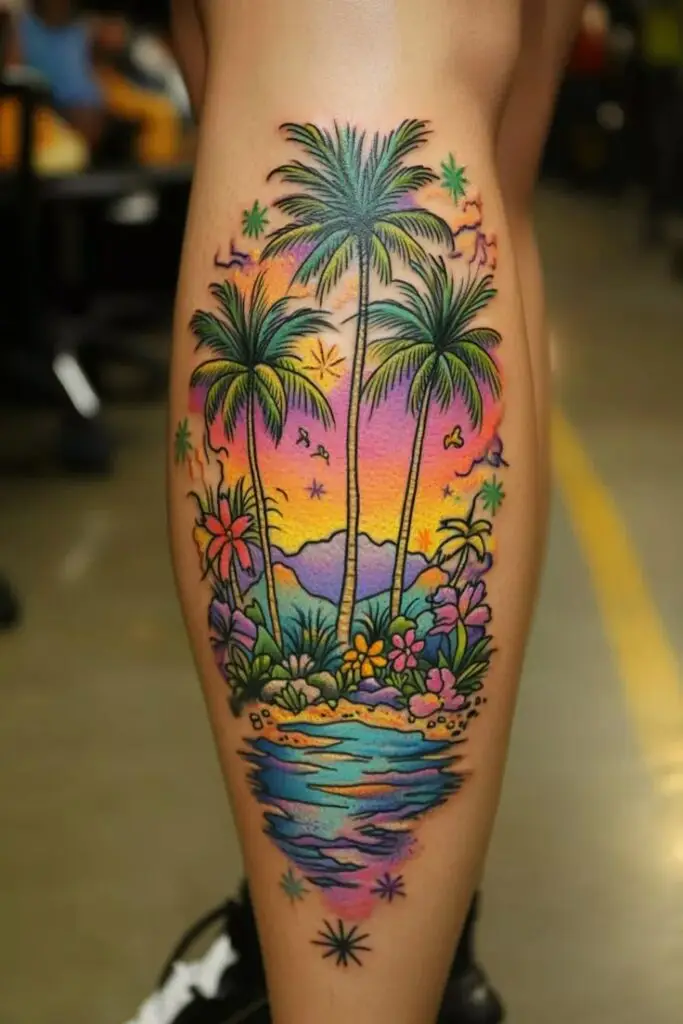


Beach tattoos often feature vibrant blue hues that replicate ocean waters, from deep navy to light turquoise. These blues create depth and movement, mimicking the ever-changing sea.
Sunset-inspired colors like oranges, pinks, and purples add dramatic flair to beach scene tattoos. Artists typically apply these using gradient techniques to achieve that signature sky-to-horizon transition effect.
Yellow tones represent both sunshine and sand, bringing warmth to the overall composition. Many tattoo artists use saturated pigments to ensure these colors maintain their vibrancy over time.
Watercolor techniques have become increasingly popular for beach tattoos. This approach creates a dreamy, fluid aesthetic that perfectly captures the free-spirited nature of coastal environments.
Blackwork and Minimalism

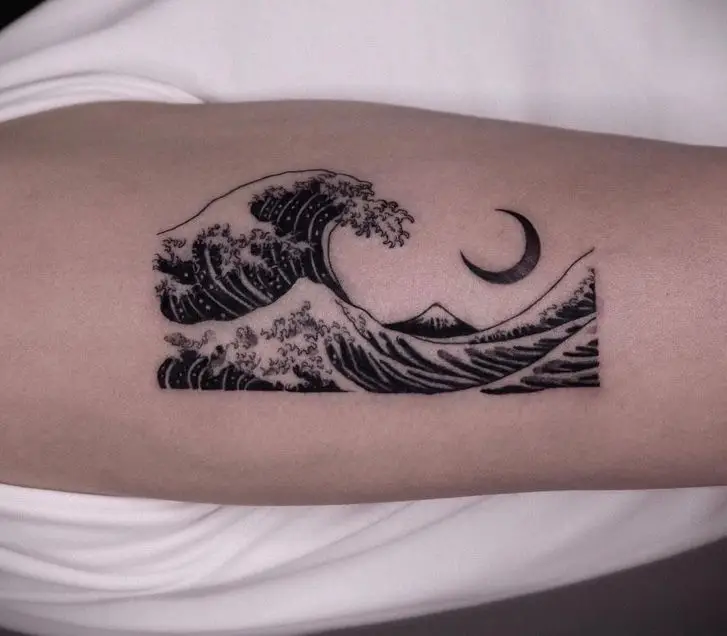
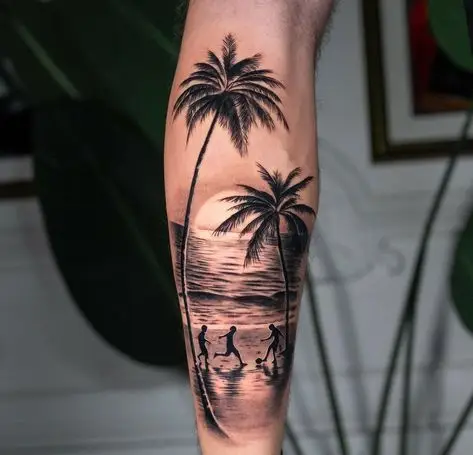
Traditional black outline work provides excellent definition for wave patterns and creates striking silhouettes of palm trees or beach landscapes. These designs often age better than their colorful counterparts.
Dotwork techniques offer texture and dimension, particularly effective for creating sandy beaches or starry night skies over ocean scenes. The concentration of dots can create subtle shading effects.
Minimalist line art has gained popularity for its elegant simplicity. Single-line beach tattoos convey the essence of waves, shells, or beach horizons with remarkable efficiency.
Black and gray shading works wonderfully for realistic beach elements like driftwood, rocks, or detailed seashells. The contrast between light and dark areas brings these elements to life.
Aftercare for Longevity
Proper aftercare is essential for maintaining the vibrancy and integrity of beach-themed tattoos, especially when they’re exposed to elements like sun, sand, and saltwater. Following correct aftercare procedures will ensure your coastal artwork stays beautiful for years to come.
Immediate Post-Tattoo Care

Fresh beach tattoos require special attention during the first two weeks of healing. Keep the tattoo covered with the bandage provided by your artist for the recommended time, usually 2-24 hours depending on the covering type.
Gently wash the tattoo with fragrance-free, antibacterial soap and lukewarm water 2-3 times daily. Pat dry with a clean paper towel rather than rubbing.
Apply a thin layer of recommended tattoo-specific aftercare ointment. Avoid petroleum-based products unless specifically advised by your artist.
Beach-specific concerns: Stay out of the ocean completely during healing! Saltwater, sand, and beach bacteria can cause serious infections in fresh tattoos.
Keep the new tattoo out of direct sunlight during the healing process. If beach days are unavoidable, keep it completely covered with clothing.
Ongoing Maintenance Tips
Once healed, beach tattoos require consistent care to preserve their coastal charm against environmental factors.
Apply broad-spectrum SPF 50+ sunscreen specifically to your tattoo whenever it will be exposed to sunlight. Reapply every two hours.
Consider protective clothing with UPF protection when spending extended time at the beach. Rash guards and swim shirts can protect chest, back, and arm tattoos.
Moisturize daily with fragrance-free lotion to keep skin hydrated. Well-moisturized skin displays tattoo colors more vibrantly.
Products to avoid:
- Exfoliating scrubs
- Skin-lightening creams
- Heavily scented lotions
- Tanning oils/beds
After ocean swimming, rinse with fresh water and reapply moisturizer. Saltwater can be drying and fade tattoos over time if not properly rinsed away.
- 651shares
- Facebook0
- Pinterest651
- Twitter0

